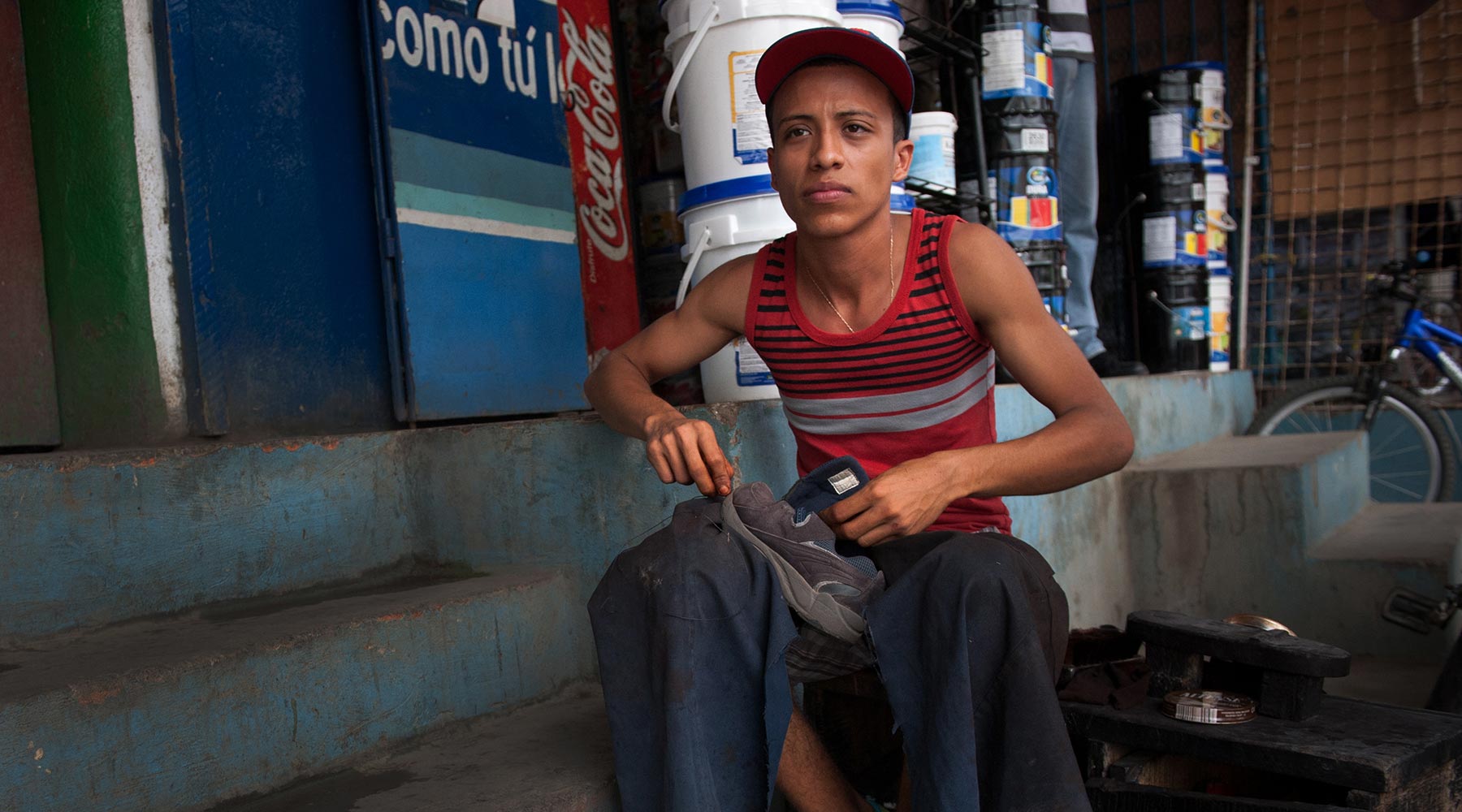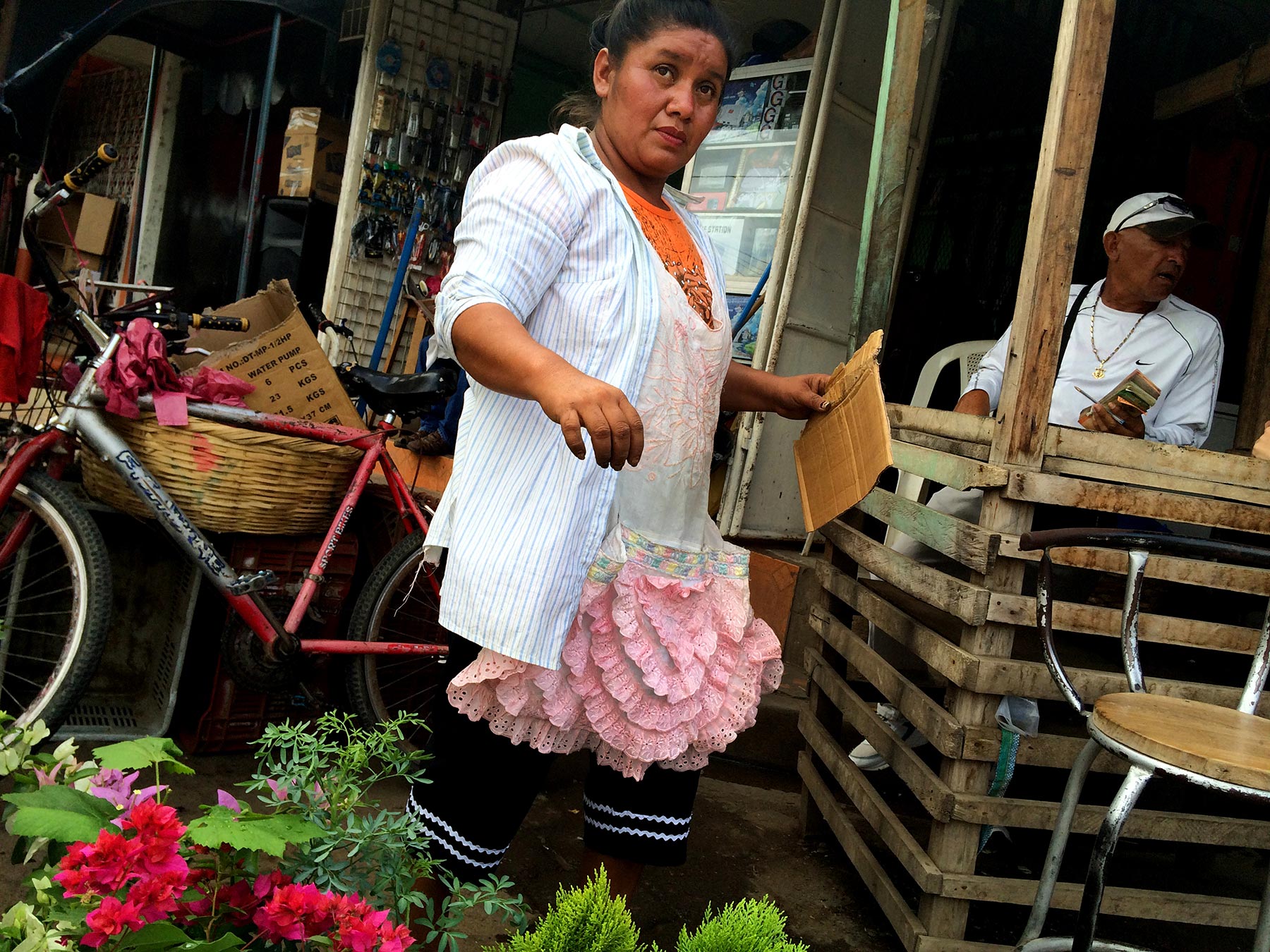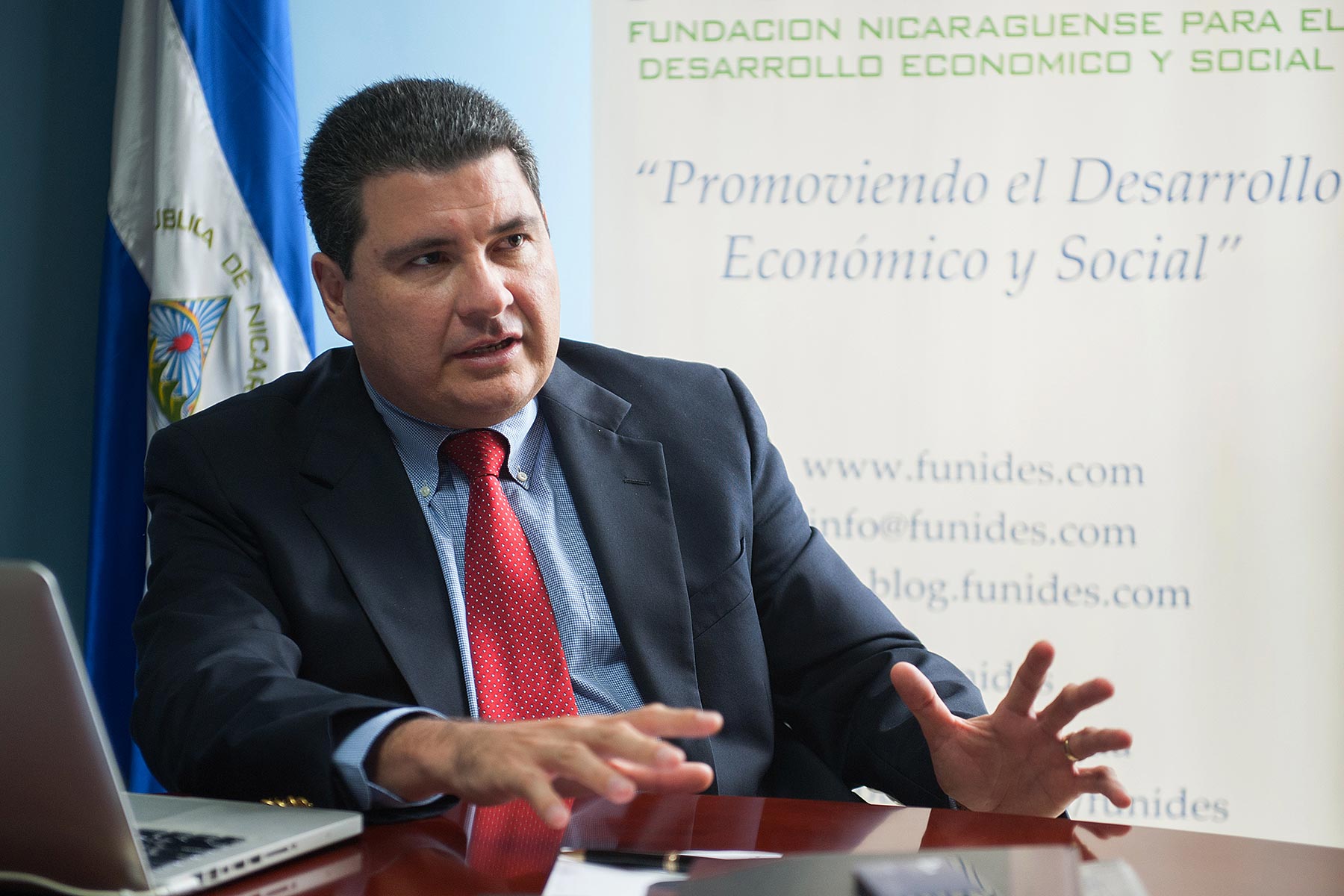
Hunger for prosperity
Canal promises to pull workers into formal economy, but many Nicaraguans skeptical they will benefit
A deep divide
Part two of a five-part series examining the impact of the Nicaragua canal.
Franciso Hurtado sits on the sidewalk of the bustling Rivas market, his attention fixed on the rubber sole he sews back on to an old grey sneaker, his nimble fingertips stained with polish the color of dried blood. A few yards away, his father, a lively, grey-whiskered man also named Francisco Hurtado, paints a pile of multicolored boat shoes a uniform black.
“There’s too many people shining shoes because there are no jobs. This is the only kind of employment there is,” said the older Hurtado.
It is a common story. Nicaragua remains the second poorest country in the Western Hemisphere after Haiti. Natural disasters, a 43-year dictatorship, a revolution, and civil war stalled economic development over the past 50 years. So even while its economy grew by more than 4 percent last year the average Nicaraguan earns less than $2,000 per year.
Unemployment stands at 7.2 percent but underemployment — which economists say is a much more revealing figure — is a staggering 46.5 percent. Meanwhile, nearly seven out of 10 jobs are in the informal sector — among the highest in Latin America according to the International Monetary Fund— whether it’s raising cattle, selling papaya, or shining shoes at a local market.
When Nicaragua’s National Assembly sped “Law 840” — the Special Law for the Development and Infrastructure of Nicaraguan Transport Related to the Canal, Free-Trade Zones and Related Infrastructure — through the National Assembly in June 2013, President Daniel Ortega pitched the Nicaraguan Interoceanic Grand Canal as the megaproject needed to finally pull this marginalized country of 6.2 million out of poverty.
“This is a project that will combat poverty, extreme poverty, and bring wellbeing, prosperity and happiness to the Nicaraguan people,” Ortega said in a June 2013 speech in Managua shortly after the 50-year concession was granted to the Hong Kong-based HKND holding company.
“It’s the dream of Nicaragua people to eradicate poverty and build a bright future. Nicaragua Grand Canal will make this dream come true,” Chinese telecom billionaire Wang Jing, HKND’s CEO, told a group of Nicaraguan engineering students, according to the company's press release on July 7, 2014, the day the canal route was approved. And at the groundbreaking ceremony in December he announced: “[W]hat we bring is wealth and dignity, and what we drive off is poverty and backwardness.”

Scroll for more


Rivas, a medium-sized city (pop. 30,000) in the relatively prosperous municipality of the same name, will be one of the first and most affected communities along the proposed canal route, as it lies just across the isthmus from the Pacific shoreline where the canal route begins and about five miles from the first locks system — the largest to ever be constructed.
HKND plans to install a construction management and operations office in Rivas, which will also host one of a handful of hiring centers. Three of nine planned worker camps — each accomodating more than 5,000 employees — will be in the surrounding area. While not yet defined, several of the canal concession subprojects — including a free-trade zone with retail complexes, hotels, and international airport — will also likely be built in this region.
Despite their proximity to the project, many Rivas residents at the market on a recent Saturday morning were skeptical that they will reap the benefits. When asked if he thinks the project will increase employment opportunities for people like him, the older Hurtado did not hesitate: “No — never — no,” he said.
“The government can give Mass [say whatever it wants] but reality is different. All governments promise things and at the end of the day nothing becomes real. Their promises don’t come true,” he said.
“I imagine they’re going to bring their own people to operate the machines and lay the brick,” he added. “They’re going to hire a few people from here but I don’t think it’s like what they’re saying. They’re not going to hire many of us.”
Source: Economist Intelligence Unit, Nicaragua Financial Economic Program, Nicaragua Triunfa! 101.
The original assumption floated by the administration of President Daniel Ortega was that the Nicaraguan canal would bring a million jobs to Nicaragua. In the latest documents released by HKND, the company estimates the project will employ 50,000 per year during the ambitious five-year construction period, up to half of whom will be Nicaraguan, 25 percent Chinese and 25 percent from other countries. A “core contingent of experienced personnel” — those who will fill management, training and equipment operation roles — will come from outside.
“We don’t have enough engineers. We don’t have enough welders. That’s why they’re talking about a high percentage of foreign labor that would have to be imported to do this if the project were to start,” said Juan Sebastián Chamorro, executive director of the Nicaraguan Foundation for Economic and Social Development (FUNIDES).
Chamorro added that the proposed canal route cuts through areas of poor education, where many residents have just a few years of schooling. “You’re talking about people that can barely write and read so [the jobs they get] will have to be very, very basic,” he said.
Despite this, Luis Adolfo Barbosa, president of the construction workers union in Nicaragua (CST-JBE), supports the project. While there is nothing requiring HKND to employ Nicaraguans, he said he’s confident the workers he represents will be employed and will learn the necessary skills by doing the work.
“We have a government committed to the people – that’s the guarantee,” he said, sitting in his office, a framed photo of him with his arm wrapped around Ortega hanging on the wall behind his desk. “The president and HKND are not going to go before us and promise us this if it were a big lie.”
Adolfo Acevedo, a prominent Nicaraguan economist, worries that the huge capital investment in the project will benefit only China and Nicaragua’s business elite, and not the 40.5 percent of Nicaraguans who live beneath the poverty level — and certainly not the nearly 10 percent who live in extreme poverty on less than $1 a day.
“In the first place, it’s not a Nicaragua canal, it’s a Chinese canal,” he said. “The biggest Chinese banks are going to finance it and the biggest Chinese businesses will build it — otherwise there won’t be a canal.”
Acevedo believes the canal itself is just a small part of the concession, and has little to do with HKND’s overall strategy in Nicaragua.
“The canal to me is not really what they’re going for. They’re going for something bigger: a logistical, financial and commercial center in the heart of the Americas,” he said. “The idea of the canal is to create a sort of Chinese Hong Kong within Nicaragua.”
If built, Acevedo said this Chinese enclave would do little to change the job structure in Nicaragua or diversify the country’s economy. Furthermore, the capital investment would be in a zone that the Ortega administration has agreed would be tax-free.
“Here there will be two tax systems,” said Acevedo. “One system for everybody, the normal system. And then there will be another system where nobody will have to pay taxes for 100 years. So who is going to invest in education and infrastructure in order for the country to develop?”
Taxes currently account for more than half of Nicaragua’s government revenue.
Acevedo believes only the biggest businesses and financiers in Nicaragua — he mentions sugar tycoon and billionaire Carlos Pellas — will have the opportunity to invest in and benefit from the canal subprojects, and those investments in the tax-free zone will further reduce the country’s already-low tax base.
“The elite in this country are placing their bets on this big business opportunity for them,” he added. “What they’re showing is that what happens to the country, they don’t really care about.”
Back at the Rivas market, the various vendors are unsure who or what to believe. Some hear the canal will bring jobs, others hear it won’t. And if development does come, they wonder at what cost to the environment and to those who will be displaced from their land.
“With so many things one hears, I just don’t know what to say. We just don’t know. We’re confused,” said Marisela Correa, who was running a produce stand.
Correa worries the producers in Rivas she buys her fruit and vegetables from, whose land lies in the path of canal, will be adversely affected.
“For instance, these things,” she said, pointing to a basket of green squash, “the people who produce them have irrigation. What happens if they’re moved to a place where there’s no water? How are they going to produce these things?”
“I think some people are going to have their land taken away. And some people say it’ll bring something good to Nicaragua, they say. I don’t know,” said Walmaro Smith, 24, sitting in the front of his bicycle taxi waiting for a fare. As a bike taxi driver, he said he makes anywhere from 200 to 600 córdobas (about $7.50 to $22) a day, and perhaps the canal will be a chance to find steady work.
“I would work laying brick,” he said. “Because I’m not going to be an engineer or a boss. But who knows.”
Ramón Gallo, 60, has a small corner stall where he sells coconuts, grains, rice, beans, bananas and other staples. Business is slow, he said, and he’s optimistic the canal will turn things around.
“There will be more people, people from other places, and there will be more economic activity happening,” he said.
Degrees of support or opposition to the canal vary from stall to stall, and even family members working alongside each other in the makeshift spaces are divided.
Karen Solís, who runs a hardware shop in the market, supports the canal.
“Now there’s few jobs and there are going to be a lot more jobs in the future … We’re all going to benefit because we’re going to sell more,” she said.
Her uncle, Jacobo Pérez, concedes the project “has its pros and cons” but waits his turn to speak with palpable impatience.
“The Chinese will bring who knows how many people. And their companies are big, so a minority of us are going to work. And they’re going to give us the worst jobs,” he said, his irritation spilling forth.
He might be right. A 78-page project overview published on HKND’s website in December offers a hint of what jobs will be made available to local workers. Canal workers will live in “closed camps” they cannot leave without permission, according to the documents. Domestic construction workers will work 12-hour shifts, 7 days a week in periods of two weeks on, one week off.
“Everyone says now there’s going to be prosperity but the truth is the Chinese will put their free-trade zones, their own businesses here, and we’ll be left with nothing,” Pérez added.
While the rest of the world questions whether the canal will overcome economic and environmental hurdles and actually get built, Pérez has no such doubts.
“You know the Comandante — he’s the boss,” he said, referring to Ortega. “If he says it’s going to go, it’s going to happen.”






